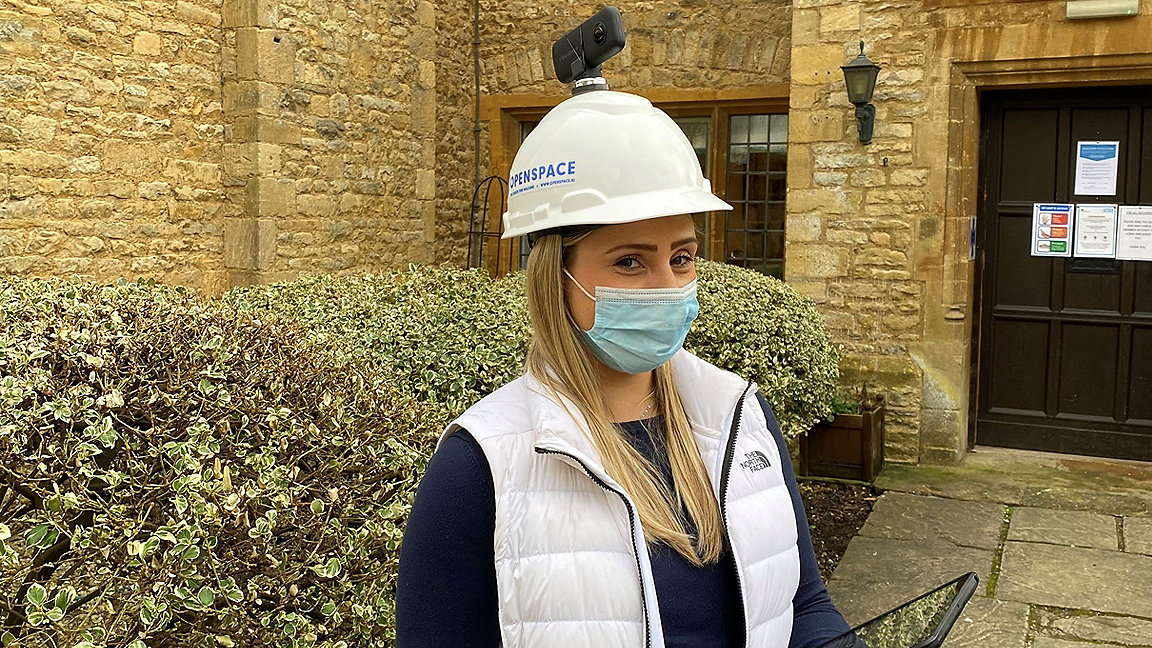
Surveyor on site and ready to go with the Insta 360 One X Camera and iPad © Eilidh Littlejohn Stojsavljević
A couple of years ago, my department at Cushman & Wakefield began an initiative to introduce a wider range of technology into our services.
The aim has been to expand services for our clients, as well as making building inspections quicker. One main benefit of introducing the Insta 360 One X cameras into our services is that it is quicker than your normal digital camera, as the Insta 360 One X allows you to film and take images at the same time.
So, over the past few months, I have been trialling an Insta360 One X camera. The benefit of being able to take real time images and videos is that it allows me to show clients their properties as and how I see them when undertaking my inspection. The camera also allows me to record my walk-through on floorplans and make defect notes during the inspection.
Of course, you need to be trained to use the camera and do the necessary preparation before heading out on site. You need to obtain floorplans from your client and create a dedicated project folder – not to mention ensuring all your equipment is fully charged. You also need to set up an account in Open Space. Open Space is an online application that links the project folder with the camera to transfer the data it collects back to a server.
Once you're on site, the camera is attached to a hard hat, which is then linked via Bluetooth or wi-fi to your tablet or smartphone. The camera then connects to the app and uses the uploaded floorplans to follow you around the building while taking real-time videos and images.
During the inspection, you can identify specific defects by taking images and notes, which are marked on the floorplans in the relevant locations. These notes can then be extracted after the inspection to provide an individual report.
Back in the office, you will need to upload all your images, video and notes to the main Open Space server. These files are then accessible from your laptop so you can show clients and colleagues.
Before and after
For my trial project, I undertook two inspections. The first was conducted after the property in question had suffered flood damage and the building was being prepared for refurbishment, and the second as these works were nearing completion.
The client was also interested in seeing how the technology worked and finding out how it could benefit them, because they did not plan to inspect the site regularly themselves.
After completing both inspections, I was able to show the client the results of the first alongside those of the second. This allowed them to see the property and the works that had been completed without having to travel to the site itself.
Speed and ease
As I tend to prefer traditional survey methods and equipment – pen, paper and camera – the trial project took me outside my comfort zone, but this always presents a great learning opportunity.
It also meant I could complete each inspection within an hour or two, so I only needed to spend minimal time out of the office on site. I was then able to report to my client on the same day.
Before the trial, I was not the biggest advocate for introducing technology into my inspections and surveying techniques. However, the trial has changed my view – for certain service lines, such as project monitoring, condition surveys, contract administration and technical due diligence.
The main reason for this is that it was quick and easy to learn how the camera works. It's user-friendly, and has saved me time both on site and in the office. It also allowed me to provide the final results to my client the same day.
Overall, the camera and software are easy to use, both for us as surveyors and for our clients. Open Space provides an interface that gives clients straightforward online access to the software, without having to download it.
We live in a time where technology is changing faster than ever. This is something we as surveyors should not be resisting; instead, we can encourage its use when opportunities become available.
Eilidh Littlejohn Stojsavljević MRICS is a senior building surveyor at Cushman & Wakefield
Contact Eilidh: Email
Related competencies include: Building pathology, Inspection
